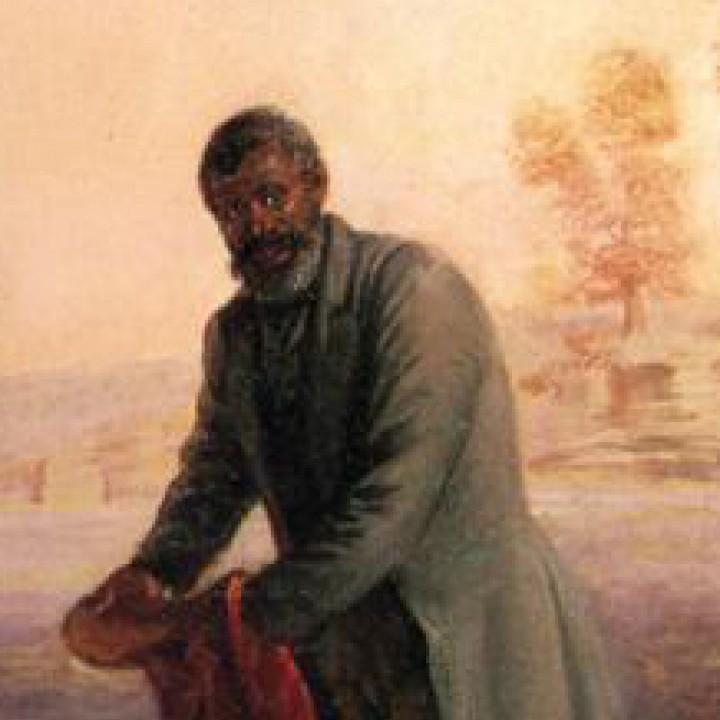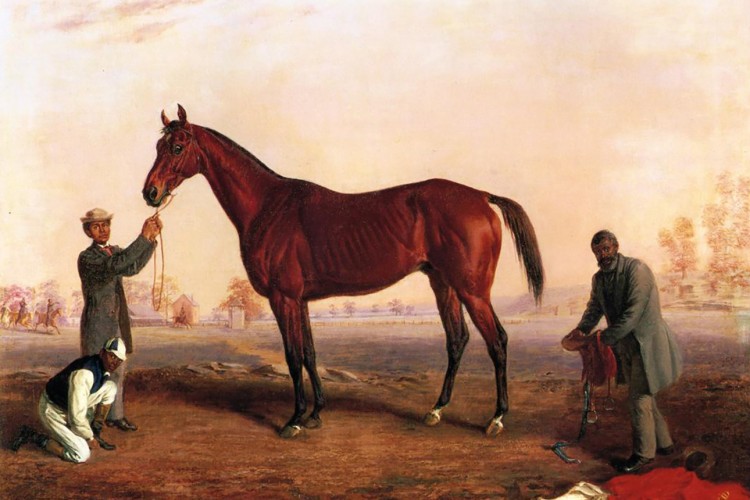
Ansel Williamson
Childhood and Family
Ansel Williamson was born into enslavement in Virginia around 1810. He married his wife
Early Career While Enslaved
The earliest record of Williamson’s career is in the 1850s while enslaved by T. G. Goldsby in Alabama. His work with horses likely began much earlier. Williamson trained Goldsby’s winning race horses for three-mile heats. He conditioned famous horses such as Brown Dick. Goldsby sold Williamson to A. Keene Richards. Williamson trained his horses Australian and Glycera.2
While working for Richards, Williamson chose Abe Hawkins, an African American jockey, to ride in races in New Orleans at the Metairie track.3
Williamson, Asteroid, and Edward Dudley Brown
In 1864, Richards sold Williamson to Robert Alexander, a wealthy Thoroughbred breeder and owner. Alexander admired Williamson’s expertise, and even named a horse after him in 1856.4
While working for Alexander, Williamson trained the horse Asteroid. He mentored the young African American jockey Edward Dudley Brown. Brown and Williamson became a successful pair who dominated racing after the Civil War.5 The artist Edward Troye created a painting of them with Asteroid.
Civil War
During the Civil War, Confederate soldiers stole horses throughout Union territory, including Kentucky. When raiders arrived at the farm of Robert Alexander, they encountered Williamson. At that time, he worked as Alexander’s trainer and stable manager. Soldiers pressured Williamson to hand over the famous horse Asteroid. But he substituted a different horse, and Asteroid remained safe.6
Career Wins
Legacy
Ansel Williamson passed away June 18, 1881, in Lexington.7 Memory of his life and career lives on in the present day. In 1998, the National Museum of Racing and Hall of Fame inducted Williamson.8 In 2011, a highway marker dedicated to the horse Aristides was installed at the University of Kentucky’s Coldstream Research Campus. This is the site of the former McGrathiana farm where Williamson trained. Though Williamson was not the main subject of the marker, it stands as a partial tribute to his successful legacy.9
Sources
“1900 United States Federal Census.” 1900. Census. Fayette County, Kentucky.
“1910 United States Federal Census.” 1910a. Census. Middleton Township, Monmouth County, New Jersey.
“———.” 1910b. Census. Sheepshead Bay, Brooklyn, New York.
“Ansel Williamson.” n.d. National Museum of Racing and Hall of Fame. Accessed April 6, 2020. https://nrm.tjctechnology.com/hall-of-fame/ansel-williamson.
Fayette County Clerk. 1870. “Marriage Record of Ansel Williamson.” Colored Marriage Records.
Kentucky Live Stock Record. 1881, June 25, 1881.
Lexington Daily Transcript. 1881, June 20, 1881.
Mooney, Katherine. 2014. Race Horse Men: How Slavery and Freedom Were Made at the Racetrack. Cambridge, Massachusetts: Harvard University Press.
“New Historical Marker to Be Unveiled at Coldstream.” n.d. UK Coldstream Research Campus. Accessed February 17, 2020. http://www.uky.edu/coldstream/News/new-historical-marker-be-unveiled-coldstream.
Saunders, James Robert. 2003. Black Winning Jockeys in the Kentucky Derby. Jefferson, N.C.: McFarland & Co.
“Williamson, Ansel.” n.d. In Notable Kentucky African Americans Database. Accessed April 6, 2020. https://nkaa.uky.edu/nkaa/items/show/676.
Yvonne Giles. 2019. “African American Horsemen in Kentucky 1825-1950.” In Tales from the Turf. Louisville, KY: J.B. Speed Art Museum.
Citation
When citing this article as a source in Chicago Manual of Style use this format: Last name, first name of Author. Chronicle of African Americans in the Horse Industry. n.d. “Title of Profile or Story.” International Museum of the Horse. Accessed date. URL of page cited.
- 1“1900 United States Federal Census.”; “1910a United States Federal Census.”; “1910b United States Federal Census.”
- 2“Ansel Williamson.”
- 3Mooney, Race Horse Men, 138.
- 4Mooney, 164.
- 5Mooney, 165.
- 6Mooney, 129.
- 7Lexington Daily Transcript, June 20, 1881; Kentucky Live Stock Record, June 25, 1881.
- 8“Ansel Williamson.”
- 9“New Historical Marker to Be Unveiled at Coldstream.”




